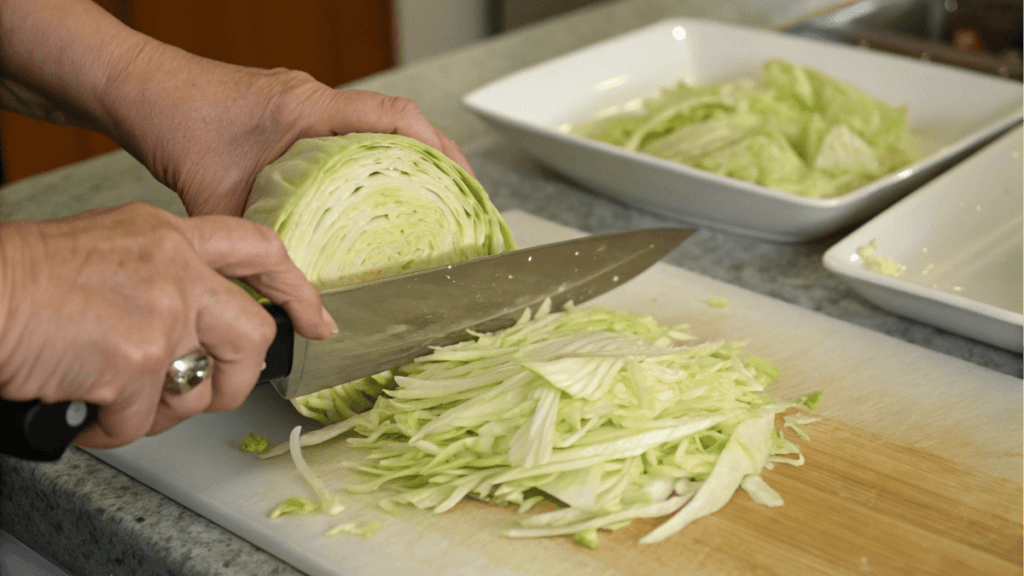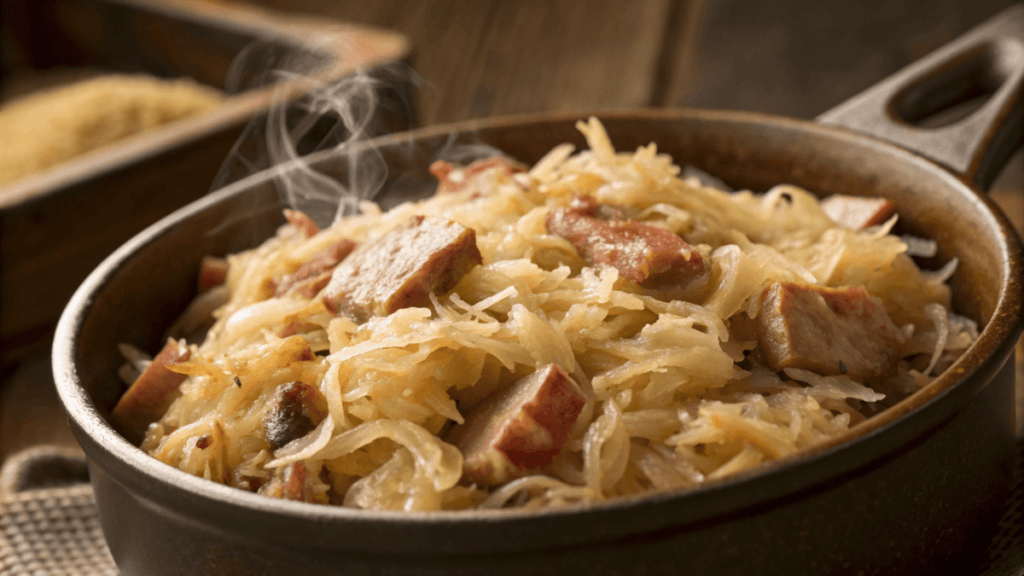The coal miner’s recipe for sauerkraut isn’t just a simple dish; it’s a culinary journey through time. Rooted in tradition and ingenuity, this tangy and versatile fermented cabbage dish was a staple for coal miners who needed nutritious, long-lasting, and flavorful meals. This article delves into the origins of this timeless recipe, breaks down its step-by-step preparation, explores its health benefits, and offers creative ways to enjoy it. Whether you’re a fan of traditional cooking or a curious foodie, this guide will walk you through everything you need to know about crafting the perfect sauerkraut.
The Origins and Cultural Significance of the Coal Miner’s Sauerkraut Recipe
Historical Roots in Coal Mining Communities
The coal miner’s recipe for sauerkraut has its roots in the hardworking mining towns of Europe and North America. For miners, the days were long, the conditions harsh, and the need for hearty, shelf-stable food essential. Enter sauerkraut—a fermented cabbage dish that packed a tangy punch and offered impressive nutritional benefits. The simplicity of the ingredients made it affordable, and its long shelf life meant it could be stored for weeks without spoiling.
Miners relied on this dish not just for sustenance but also for the energy and immune-boosting benefits of fermented foods. Over time, sauerkraut became a symbol of resilience, practicality, and the enduring spirit of those who made a living deep beneath the earth.
Why Sauerkraut Became a Staple for Miners
Sauerkraut wasn’t just a convenient food; it was a necessity. Cabbage was cheap, abundant, and easy to preserve through fermentation. The natural probiotics it provided supported gut health, while the Vitamin C content helped ward off illnesses like scurvy—an invaluable trait in an era when fresh produce wasn’t readily available year-round.
For coal miners, who often worked in isolated, resource-scarce regions, sauerkraut became a lifeline. Its sharp, tangy flavor also added excitement to otherwise bland meals, transforming a basic ingredient into something truly memorable.
Connection to Tradition and Sustainability
What makes the coal miner’s recipe for sauerkraut so special is its deep connection to tradition. Families passed down their methods, tweaking flavors with spices like caraway seeds or juniper berries to make it uniquely their own. Beyond its cultural significance, sauerkraut also embodies sustainability—transforming a humble head of cabbage into a dish that minimizes waste and maximizes nutrition.
Even today, making sauerkraut at home feels like preserving a piece of history. It’s a reminder of the resourcefulness of generations past and their ability to create something extraordinary out of simple, everyday ingredients.
With its rich history and cultural ties, the coal miner’s recipe for sauerkraut is more than a dish—it’s a tribute to resilience and ingenuity. Up next, we’ll look at the ingredients and tools you’ll need to recreate this iconic recipe in your own kitchen.
Ingredients and Tools for the Perfect Coal Miner’s Sauerkraut
Essential Ingredients for a Traditional Sauerkraut Recipe
The heart of the coal miner’s recipe for sauerkraut is its simplicity. At its core, all you need is fresh cabbage and non-iodized salt. Cabbage serves as the base, while the salt draws out moisture and creates a brine that kickstarts the fermentation process. It’s best to use green or red cabbage with tight, crisp leaves for optimal texture. Non-iodized salt, like sea salt or kosher salt, ensures no additives interfere with the fermentation.
Optional Add-ins to Enhance Sauerkraut Flavors
While traditional sauerkraut is delicious on its own, miners and home cooks alike often added ingredients to personalize their batches. For a warm, earthy flavor, toss in caraway seeds or juniper berries. Want a kick of heat? Add chili flakes or smoked paprika. Garlic cloves or dill can provide bold, aromatic undertones, making your sauerkraut stand out.
Tools You’ll Need for the Best Sauerkraut
The right tools make the process smooth. A large mixing bowl, a sharp knife, and a sturdy cutting board are essential for shredding cabbage. For fermentation, use a sanitized glass jar or ceramic crock to prevent contamination. Finally, a fermentation weight or smaller jar filled with water helps keep the cabbage submerged in its brine, ensuring successful fermentation.
Step-by-Step Guide to Making Coal Miner’s Sauerkraut
Preparing Ingredients for Your Homemade Sauerkraut

First, gather your cabbage and salt—the foundation of the coal miner’s recipe for sauerkraut. Remove the outer leaves and core the cabbage. Slice it finely using a sharp knife, aiming for even shreds to ensure consistent fermentation. Once shredded, sprinkle 1 tablespoon of salt per 1.75 pounds of cabbage and toss well.
The Fermentation Process of the Coal Miner’s Recipe
Next, massage the salted cabbage with your hands until it begins to release its natural juices. This step is crucial, as the liquid will become the brine that covers the cabbage during fermentation. Pack the cabbage tightly into a sanitized jar or crock, ensuring there are no air pockets. Use a tamper or your fist to press it down firmly.
Then, place a clean fermentation weight or a smaller jar filled with water on top of the cabbage to keep it submerged under the brine. Cover the container loosely with a breathable cloth or lid to allow gases to escape during fermentation.
Store the jar in a cool, dark place with a consistent temperature of 65–75°F. Check it daily to ensure the cabbage remains submerged and to skim off any surface scum.

Common Mistakes in Making Sauerkraut and Fixes
Fermentation mishaps happen, but most are fixable. If mold forms, simply remove it along with any exposed cabbage. If the brine level is too low, top it off with boiled, cooled salted water. And don’t forget to taste-test! After 7–14 days, your sauerkraut should develop the tangy flavor characteristic of the coal miner’s recipe for sauerkraut.
With these steps, you’ll transform humble cabbage into a delicious, crunchy, and tangy masterpiece. Up next, discover why this dish isn’t just tasty but also a nutritional powerhouse!
No highly relevant internal links were found for the topic. However, readers interested in recipes with rich flavors might also enjoy exploring other comforting dishes. For more ideas, check out The Ultimate Guide to New Orleans Soaked Salad Dressing Recipe for a tangy delight.
Nutritional Benefits of the Coal Miner’s Sauerkraut Recipe
Probiotics in the Coal Miner’s Sauerkraut
One of the standout features of the coal miner’s recipe for sauerkraut is its abundance of probiotics. These live bacteria, formed during fermentation, support gut health by promoting better digestion and enhancing the gut microbiome. Regular consumption can help alleviate bloating, improve nutrient absorption, and even boost immunity.
Vitamins and Nutritional Value of Sauerkraut
Sauerkraut is more than just a tangy treat—it’s a nutritional powerhouse. Packed with Vitamin C, it’s ideal for supporting a strong immune system. Additionally, it contains Vitamin K, crucial for bone health and proper blood clotting. The antioxidants present in cabbage, such as lutein and zeaxanthin, help combat harmful free radicals, protecting the body from oxidative stress.
How Sauerkraut Supports Gut and Immune Health
The combination of fiber and probiotics in sauerkraut makes it excellent for maintaining digestive regularity. Plus, its fermented nature produces short-chain fatty acids that contribute to overall gut health. This, in turn, has a ripple effect on your immune system, keeping you healthier in the long run.
Whether you’re eating it for its tangy flavor or health benefits, sauerkraut made using the coal miner’s recipe delivers an impressive nutritional boost with every bite.
Creative Variations and Flavor Enhancements
Adding Spices and Herbs
Elevate the coal miner’s recipe for sauerkraut with a few thoughtful additions. Traditional choices like caraway seeds or juniper berries bring warm, earthy notes. For an aromatic twist, add crushed garlic cloves or a handful of fresh dill. These small tweaks can completely transform the dish, making it uniquely yours.
Regional and International Twists
Why not take this timeless recipe on a global journey? Incorporate turmeric and ginger for an Indian-inspired flavor. Alternatively, Mediterranean lovers can try oregano and lemon zest, while soy sauce and sesame seeds give it a distinct Asian flair. Each variation offers a new perspective on this classic dish.
Experimenting with Fermentation Times
The fermentation process is as flexible as your taste preferences. For a milder sauerkraut, ferment for just a week. Prefer a bolder, tangier profile? Let it sit for up to three weeks. No matter the duration, each batch captures the essence of the original coal miner’s recipe for sauerkraut.
By experimenting with flavors and fermentation times, you’ll create a personalized version of sauerkraut that stands out, whether as a standalone dish or a zesty accompaniment. Up next, discover creative ways to serve and pair this versatile dish!
Serving Suggestions and Pairing Ideas
Traditional Pairings with the Coal Miner’s Sauerkraut
The coal miner’s recipe for sauerkraut shines when paired with hearty, rustic dishes. Serve it alongside smoked sausages like bratwurst or kielbasa to complement their rich, savory flavors. For an even more traditional meal, combine sauerkraut with roasted pork loin or tender pork chops. Adding creamy mashed potatoes balances the tangy crunch of sauerkraut, creating a comforting and satisfying plate.
Sauerkraut as a Modern Sandwich and Bowl Ingredient
Sauerkraut’s versatility makes it a fantastic addition to contemporary meals. Layer it in a Reuben sandwich with corned beef, Swiss cheese, and Russian dressing for a mouthwatering classic. Add it as a topping for pulled pork sliders or even a juicy burger to give your meal a zesty kick. For a healthier option, try incorporating sauerkraut into grain bowls. Pair it with quinoa, roasted vegetables, and a lean protein for a meal that’s both delicious and nutrient-packed.
Innovative Recipes Using Sauerkraut
Go beyond the basics and discover unique ways to enjoy the coal miner’s recipe for sauerkraut. For instance, use it as a pizza topping to add a tangy twist, or stir it into a hearty soup to enhance its depth of flavor. Additionally, for a creative appetizer, pair sauerkraut with crackers, cured meats, and cheese on a charcuterie platter. Consequently, these innovative ideas allow you to explore the endless potential of this timeless dish.
FAQs About the Coal Miner’s Sauerkraut Recipe
What spices to add to sauerkraut?
When making sauerkraut, there are several spices you can add to enhance its flavor. For instance, caraway seeds are a classic choice, providing a nutty, slightly peppery flavor. Additionally, mustard seeds can offer a subtle tang and a bit of heat. If you’re looking for more aromatic flavors, adding garlic, dill, or bay leaves will elevate the taste. Furthermore, for those who prefer a spicier kick, adding red pepper flakes or crushed chili peppers works wonderfully. Ultimately, the choice of spices depends on your personal taste, so feel free to experiment and create a sauerkraut that suits your flavor preferences.
What Meat Goes Best with Sauerkraut?
The tangy flavor of the coal miner’s recipe for sauerkraut pairs beautifully with smoked sausages, such as bratwurst and kielbasa. It’s also an excellent match for pork chops, roasted pork loin, and even corned beef. Its bright acidity cuts through the richness of fatty meats, creating a balanced and flavorful meal.
How to make sauerkraut better?
To make sauerkraut better, you can experiment with various ingredients and techniques. For example, adding spices like caraway seeds, juniper berries, or garlic can enhance the flavor profile and give the sauerkraut a unique twist. Moreover, incorporating shredded carrots, apples, or even a bit of ginger can balance the tartness with a subtle sweetness. Additionally, ensuring that the cabbage is fully submerged in the brine will help it ferment evenly and prevent spoilage. Finally, be sure to let the sauerkraut ferment for the right amount of time—around 1 to 3 weeks—so it reaches its optimal flavor and tanginess.
What can be added to sauerkraut to make it taste better?
To enhance the flavor of sauerkraut, consider adding ingredients that complement its tangy profile. For instance, spices like caraway seeds or juniper berries can introduce earthy, traditional notes, while crushed garlic cloves or dill add a bold, aromatic kick. Additionally, for a touch of heat, chili flakes or smoked paprika work wonders. If you prefer a sweeter balance, shredded carrots, apples, or a splash of apple cider can bring a mild, natural sweetness. Ultimately, these additions can elevate the flavor of sauerkraut, making it uniquely suited to your taste.
What is the brine solution for sauerkraut?
The brine solution for sauerkraut is a simple mixture of water and salt. Typically, the ratio is about 1 to 3 tablespoons of salt per quart of water, depending on how salty you want the brine to be. Next, the salt draws out moisture from the cabbage, creating the brine that ferments the sauerkraut. In addition, some people like to add a little bit of sugar or whey to jumpstart the fermentation process. Once prepared, this brine should cover the cabbage completely during fermentation to ensure even pickling.
Preserving the Tradition: Why Make Sauerkraut at Home?
Connecting to History with the Coal Miner’s Sauerkraut Recip
The coal miner’s recipe for sauerkraut is more than just a dish; it’s a slice of history that connects us to a simpler time. For generations, coal miners relied on this tangy and nutrient-packed food to sustain them through long, grueling workdays. By recreating this recipe at home, you’re honoring their resilience and ingenuity while keeping a timeless culinary tradition alive. Every batch of homemade sauerkraut becomes a story, linking the past to the present in a meaningful way.
Benefits of Homemade Sauerkraut Over Store-Bought
Making sauerkraut at home offers benefits that store-bought versions simply can’t match. Homemade sauerkraut is fresher, richer in probiotics, and free from preservatives or artificial additives. Additionally, you have the freedom to tweak the flavors, creating a batch that reflects your personal taste. Whether you prefer traditional spices like caraway seeds or bold twists with chili flakes, the possibilities are endless.
Preserving the Tradition of Making Sauerkraut at Home
The beauty of the coal miner’s recipe for sauerkraut lies in its simplicity and adaptability. In a world dominated by convenience foods, taking the time to make sauerkraut at home reconnects us with the art of cooking from scratch. By sharing this tradition with family and friends, you’re not only creating a delicious dish but also passing down a piece of culinary history that deserves to be celebrated.
With its rich history, nutritional value, and endless versatility, this recipe is a must-try for anyone who loves food that tells a story.

